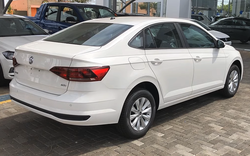Latin America
The made-in-Brazil Volkswagen Virtus was sold in Latin America with a standard safety specification of four airbags including two frontal airbags and two seat-mounted side combination torso-head airbags, i-Size approved ISOFIX anchorages, three-point seatbelts in all seats, front and rear seatbelt pretensioners. Electronic Stability Control and post-collision braking were sold in volumes high enough for a Latin NCAP 2.0 five star rating.
The Virtus was tested by Latin NCAP 2.0 in 2017 and achieved five stars for both adult and child protection, performing well across all areas of assessment including the ESC test and side, front and pole impacts (the last two were carried over from the Polo based on technical evidence supplied by Volkswagen). The Virtus also received an award from Latin NCAP Advanced for its pedestrian protection. [18]
2018 Volkswagen Virtus + 4 airbags, made in Brazil| Latin NCAP 2.0 scores (2018) |
| Adult occupant stars |      |
| Frontal offset impact | 15.68 max. 16.00 |
| Side Impact | 15.88 max. 16.00 |
| Seatbelt reminders | 1.00 max 2.00 |
| Side HPD - Pole test | Pass |
| ESC - GTR8 sin-dwell test | Pass |
| Child occupant stars |      |
| Q1.5 dynamics | 12.00 max. 12.00 |
| Q3 dynamics | 10.00 max. 12.00 |
| CRS installation check | 12.00 max. 12.00 |
| Vehicle-based assessment | 9.00 max. 13.00 |
| Latin NCAP Advanced |
| Award 2018 - Pedestrian Protection (UN 127) [19] |
In 2020, Latin NCAP introduced a geometric evaluation for head protection airbags for rear occupants; [20] the updated Virtus for Latin America is equipped with curtain airbags instead of the older seat-mounted combination torso-head airbags, and is fitted with rear-seat belt reminders. [21] Higher trim levels are also sold with Autonomous Emergency Braking, which is part of Latin NCAP's 2020 assessment protocols. Latin NCAP 3.0 reassessed the facelifted Virtus for Latin America in 2022 (similar to Euro NCAP 2014), and it achieved the maximum five star safety rating.
2022 Volkswagen Virtus + 6 airbags, made in India or Brazil| Latin NCAP 3.0 scores (2022, similar to Euro NCAP 2014) [22] |
| Adult occupant protection | Child Occupant Protection | Vulnerable Road Users | Safety Assist Technologies |
| Score | 92% | Score | 92% | Score | 53% | Score | 85% |
| Maximum star rating |      | Maximum star rating |      | Maximum star rating |      | Maximum star rating |      |
| Overall rating |      |
India
The Virtus is sold in India with a standard safety specification of two frontal airbags, i-Size compatible ISOFIX anchorages, Electronic Stability Control, three-point seatbelts for all seats, front and rear seatbelt pretensioners, post-collision braking and a tyre pressure monitor. Higher trim levels are fitted with front-seat side torso airbags, and front and rear head-protecting curtains.
In April 2023, the Virtus was awarded five stars for adult and child occupant protection by the Global New Car Assessment Programme (Global NCAP, based on Latin NCAP 2016) under its Safer Cars for India project after testing performed at Škoda's expense. [23] In the frontal offset impact of the Virtus' corporate twin, the Škoda Slavia, against a deformable aluminium honeycomb at 64km/h, dummy readings indicated low or limited risk of serious injury to all critical body regions, the passenger compartment remained stable and Škoda demonstrated that the car's dual retractor-lap pretensioning system would protect the knees of occupants of different sizes or seating positions from impact with hard points in the fascia. However, moderate rearward intrusion of the brake pedal into the footwell resulted in protection of the driver's feet being rated marginal.
In the side mobile barrier impact, performed on a Virtus unit, deceleration of the driver's head indicated there was hard contact with the roof liner, and protection was downrated to adequate despite dummy readings of HIC not indicating a high enough risk of serious injury. Dummy readings of deflection of the driver's ribs and forces in his pubic symphysis indicated a limited risk of serious thoracic and abdominal injury. In the side pole test, dummy readings of rib deflection indicated a moderate risk of serious fracture, but the optional curtain airbags fitted to the test unit worked well to produce head injury readings well within the tolerances allowed.
Using the Britax Dualfix child restraints selected by Volkswagen and installed rearward-facing using i-Size anchorages, both the child dummies achieved maximum points for dynamics, but the Virtus lost points in the vehicle-based portion of the assessment because it does not offer a means to disconnect the front passenger airbag, should the need to install a rearward-facing child restraint on that seat arise. The Virtus met minimum European regulatory requirements for electronic stability control performance and pedestrian protection.
The rating for the Virtus has not yet been extended to Global NCAP's Safer Cars for Africa project. In South Africa, where the Virtus is sold as the Polo Sedan, side thorax or head (curtain) airbags are not available on any variant, so the Polo Sedan will not be eligible for the side pole test required for a rating of four stars or better. [24] [25]
2023 Volkswagen Virtus, RHD| Global NCAP 2.0 scores (2023) |
| Adult occupant stars |      |
| Adult occupant score | 29.71/34.00 |
| Child occupant stars |      |
| Child occupant score | 42.00/49.00 |








